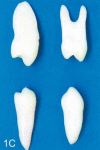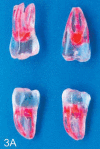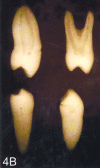Critical analysis of artificial teeth for endodontic teaching
- PMID: 19089288
- PMCID: PMC4327279
- DOI: 10.1590/s1678-77572008000100009
Critical analysis of artificial teeth for endodontic teaching
Abstract
The purpose of this study was to evaluate the use of artificial teeth for endodontic teaching. A questionnaire was prepared and submitted to 18 professors of Endodontics from different Brazilian universities to evaluate the following features of five cloudy resin artificial teeth: internal and external anatomy; coronal chambers regarding their size, shape and canal path; root canal regarding their size, shape and position; fulfillment of the pulp chamber and root canals by considering the texture, quantity, color, and ease of handling; resin hardness and visualization of the radiographic image. The results presented favorable opinions, in terms of internal and external anatomy, coronal pulp chambers and root canal and handling and radiographic imaging. The contents of the pulp space and hardness of the teeth were considered satisfactory. The average grade assigned to the artificial tooth quality was 8.4, in a 0-10 scale. In conclusion, the artificial teeth have potential to replace the natural teeth in endodontic teaching; however, improvements are still necessary to reach a better quality model.
Figures













References
-
- Dummer PMH, Alodeh MHA, Al-Omari MAO. A method for the construction of simulated root canals in clear resin blocks. Int Endod J. 1991;24:631–636. - PubMed
-
- Hasselgren G, Nellestam P, Bynum-Hasselgren R. Teeth with transparent roots – an improved teaching aid for preclinical endodontics. J Endod. 1987;13(3):126–127. - PubMed
-
- Hasselgren G, Tronstad L. The use of transparent teeth in the teaching of preclinical endodontics. J Endod. 1975;1(8):278–280. - PubMed
-
- Jackson AP, Tidmarsh G. Simulation models for teaching endodontic surgical procedures. Int Endod J. 1993;26:198–200. - PubMed
-
- Kahn HA. Preclinical dentec for teaching endodontic procedures. J Endod. 1983;9(11):506–509. - PubMed
Publication types
MeSH terms
Substances
LinkOut - more resources
Full Text Sources

